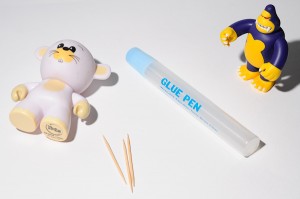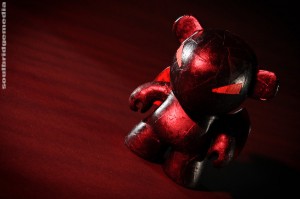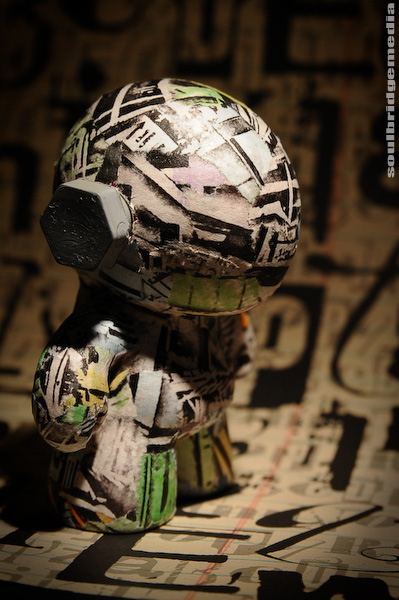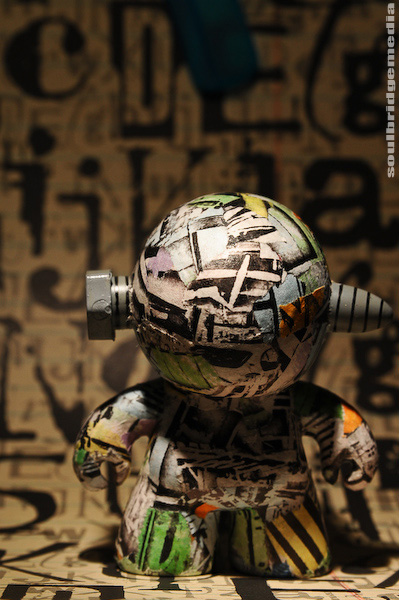Customising your own Kid Burner
Ok so you want to build an army of custom minions to do your bidding or perhaps the Rsvp’s to your tea parties look a little thin? Then its time to get your Martha Stewart on.
If you’re thinking “Ay? What’s this all about?” then you need to have a quick read of this. For those up to speed, continue reading.
These are the steps to create a simple decoupage’d custom
-
Step 1.
You’ll need a few supplies

Ask for help if you need to, just dont ask Ken. He has minimal articulation 😉
1.a) Hey doll! – Nooks knock off toy. These are available from Cardiology. As these are privately run franchises, stocks vary between stores. I have been getting mine from the Garden City store (Mt Gravatt, Brisbane) as the city store doesn’t stock them. Call ahead to save yourself a trip. They’re $10ea. If you’re planning on doing a few of them, ask for the loyalty card, buy 10 get one free. (unfortunately I only found out about it after I had already bought 10!)
b) Choosing your Nook. There’s quite a variety of different shapes and colours (you can get an idea from their site), so choose one to match your mental blueprints. Depending on the colour of paper, you may want to choose one that matches or best compliments the colour you’re working with. If you’re after predominately white or black characters, the mouse and the skeleton respectively are the way to go.
2. Get the – Paper. The sky is the limit for this. You can use anything from newspaper to wrapping paper to butcher’s paper. Have a look round the house or pop down to your craft/discount store. The only thing to remember, it has to be rather absorbent and not too thick so the glue can soak in, which makes it stick better and is a lot easier to work with ie. More pliable around edges and curves. Beware of papers that have a high gloss, super smooth finish or are woven, these can have
a plastic/cellophane content and are really tough to work with. If you’re not sure, you can test your paper by cutting off a small piece adding a drop of water, then seeing if it will mould and stay around the edge of the foot. If it doesn’t stick or hold its shape when you crease or fold it then you might have to choose different paper.
3. Stuck on you – Glue. The cheaper and thinner the better! You’ll need to soak the paper in glue so the thinner it is the more likely it will soak right through. This also gives a light lacquer finish on the final product. I used a simple glue pen. Great for controlled, no mess application and readily available. IGA has them for .92c
4. Ya – Tool. This will be used for applying/spreading glue and selecting, positioning and “working” pieces. I chose a couple good quality round toothpicks. Cheap and plentiful. The point is used to press the paper into creases and joins ie. Around the neck and arms and also to “magnet” pieces so you don’t need to put everything down each time you add a piece. The round edge will help you roll pieces flat, mould them to contours and edges and also to disperse excess glue. You’ll want something that will sit comfortably in your fingers, so find something that suits you, wooden skewers or disposable chopsticks are also options.
5. ob ja dart – Other bits and pieces. The rest are things you should have lying around the house and will just help make your customising a bit easier. Clear working area – little bits of paper + glue = mess in any language. Scissors – for cutting decou bits or for those corners that just don’t crease. Something small to “fence” or contain your decou clippings from exploding everywhere at the first sign of a cough or if you sit down too fast, I use a large roll of sticky tape. Damp cloth – for stray glue bits or if your fingers or tool get sticky. Drying rack – something to sit the little guy on with minimal contact while its drying, I used an up turned flat backed power adapter.
- Step 2
Prepping the toy. If you’re using lighter coloured paper you may need to go over the painted areas of the original toy so they don’t show through. You can give it a quick light coat of ACRYLIC paint in a similar colour or if it’s a predominantly white one, at a pinch you can use “white out” tape.
-
Step 3
Paper prepping. Tear or cut your paper into random shapes and sizes roughly 1-2cm (Note: larger pieces can be harder to work around contours and edges). Torn paper = greater absorption and bonding to other pieces. Works better for random patterns. Cut paper = better for joining/matching up repetitive patterns. To minimise overlaps, joining edges need to be straight. As the space is filled you’ll have to start tailoring the pieces to fit exact spots.
-
Step 4
Decou-ing. I start from the top down. Apply a liberal blob of glue round the top, front and back of the head. Make sure its nice and thick, not too the point its dribbling but enough to wet and soften the paper. Any excess can be wiped or “squeegeed” later. Don’t worry about the glue drying on one side while youre working on another, it takes quite some time to dry by itself (~15-30min). Start with the larger pieces to cover more of the easy areas first. Place a piece on the gluey area then lightly dab it round the edges with your toolpick. When it starts sticking, roll from the center out, just like if you were rolling out a pizza base with a rolling pin. This kneads the paper and helps it absorb the glue and also squeegees the excess glue out. If some parts pop up or don’t make flush contact, add a couple dabs of glue on top of the paper, this will soften the paper
and make it more pliable. Some of the acute angles like on the feet or hands, you may need to soak the piece in glue and let it sit or even add a drop of water to the piece before sticking it to the body.
Stick torn pieces with a little overlap and cut pieces edge on edge to help make a smoother finish. Too much overlap it may end up lumpy, too little and youll have thin/clear spots that you will have to go over with pin head sized pieces.
Once you finish the head and body, you’ll find less dry spaces to hold, so it’s a good idea to do it in parts, allowing the sections to dry in between. I used an upturned power adapter as a cradle to sit its head in so there would be minimal contact and less chance of it falling over while drying. Those of you in countries that only have 2 prong adapters may need to find an alternative. Once dried, go over the completed areas and make sure there are no air bubbles or stray/rough edges. Some can be pressed down with your finger nail while others may need going over again with an extra dollop of glue.
For finer details around the around the neck and arms, you can choose to lock it in a London guard position by decou-ing over the joints or if you want movement you can use a scalpel afterwards.
Take extra care to roll the feet flat, the dolls are nose heavy and topple easily. When its almost dry, find a flat surface and press down hard to make sure they can stand their ground.
-
Step 5
Finishing. Once you’ve finished gluing, give it overnight to dry then check for any gaps or thinner areas in the paper. Touch up accordingly, allow to dry then add your final touches, paint, pen or glue on other features or accessories and you’re done!
Here’s one that i whipped up using the dragon analogue

Been busy? Hit us up in the comments with your own custom vinyls!
Nuked Nooks
 A few months ago we stumbled across what can only be described as blatant ripoffs of Kidrobot Munnys. They’re called Nooks. The basic body mould and arms are pretty close (except they’re made from a cheap soft pvc blend. The arms are even softer along the lines of a dog’s chew toy, but more on that later) to that of the Munnys while the heads are an oblong sphere skewed towards the front. The main difference lies in the different styles of characters. Each one is a different “thing”, ranging from standard animals: mouse, cow, kangaroo to mythical creatures like a dragon or a Cyclops guy with a bolt through its head or people like nurses and kings. So each character has a different add on to the basic mould be it wings, tails, horns or ears along with a terrible attempt at personalising with a name, favourite game, “friend” and a rego number to take to the seizure inducing Teletubby designed website. What it is for, I can’t tell you, but as soon as I get a hold of a 5yo, I’ll let you know.
A few months ago we stumbled across what can only be described as blatant ripoffs of Kidrobot Munnys. They’re called Nooks. The basic body mould and arms are pretty close (except they’re made from a cheap soft pvc blend. The arms are even softer along the lines of a dog’s chew toy, but more on that later) to that of the Munnys while the heads are an oblong sphere skewed towards the front. The main difference lies in the different styles of characters. Each one is a different “thing”, ranging from standard animals: mouse, cow, kangaroo to mythical creatures like a dragon or a Cyclops guy with a bolt through its head or people like nurses and kings. So each character has a different add on to the basic mould be it wings, tails, horns or ears along with a terrible attempt at personalising with a name, favourite game, “friend” and a rego number to take to the seizure inducing Teletubby designed website. What it is for, I can’t tell you, but as soon as I get a hold of a 5yo, I’ll let you know.
Despising aside, I thought, these could actually come in handy. Instead of spending $20-30AU to purchase a 4″ DIY Munny locally that I could potentially ruin, I can pay half that and practice on the cheapy instead. So in doing that I’ve created a little how to for those wanting to get their art on and letting a bit of creativity run wild.
The first thing I tried was a simple coat of paint to get rid of the ugly faces and colours. As mentioned theyre made from a soft pvc type plastic which causes some problems with adhesion and drying. If you apply very light coats (I used a cheap enamel spray paint) allowing drying time between each coat, the body and head seems to dry ok, however if you get it even slightly thicker in places, it will have a tacky texture. As for the arms, forget about it. They stay just as wet as the day you sprayed them. So you will need a pvc specific type paint (I’m still trying to track down the best type for the job) for it to dry and adhere properly. Not having this handy at the time I instead decoupaged it in plain paper and then repainted it.
The other option of course is decoupage from the start, basically covering the whole thing in small bits of paper with glue, paper Mache style, and this is what we’ve done. I will detail the process I used in a future post.
Till then, a sneak peak of one I whipped up. In tribute to the Kid Robot knock offs I’m aptly naming them Kid Burners (:


